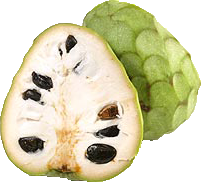|
Very sweet andpleasant flavour annonas contain an impressive list of essential nutrients,
vitamins, anti-oxidants and minerals.
The fruit has
calories equivalent to that of mangoes. 100 g of fresh fruit pulp provide about
75 calories. It is, however, contain no saturated fats or cholesterol. It characteristically
contains a good amount of dietary fibre (3 g per100 g) that helps prevent
absorption of cholesterol in the gut. The fibre also helps protect the mucous
membrane of the colon from exposure to toxic substances by binding
cancer-causing chemicals in the colon.
Cherimoya
contains several poly-phenolic antioxidants. Among them, the most prominent in
annona family fruits are Annonaceous acetogenins. Acetogenin compounds such as
asimicin, bullatacinare...etc are powerful cytotoxins and have been found to
have anti-cancer, anti-malarial, and anti-helminthes properties.
It is very good
in vitamin-C. Vitamin C is a powerful natural antioxidant. Consumption of
fruits rich in vitamin C helps the human body develop resistance against
infectious agents and scavenge harmful, pro-inflammatory free radicals from the
body.
In addition,
cherimoya fruit is a good source of B-complex vitamins, especially vitamin B-6
(pyridoxine). 100 g fresh fruit provides 0.257 mg or 20% of daily-recommended
levels. Pyridoxine helps keep-up GABA neuro chemical in the brain. High GABA
levels calm down nervous irritability, tension, and headache ailments.
Further, it has a
well-balanced sodium-potassium ratio. A good potassium level in the body helps
control heart rate and blood pressure, and thus, counters the bad influences of
sodium. It also contains more minerals weight per weight than many common
fruits like apples, rich in copper, magnesium, iron and manganese.
Digestive system: Cherimoya possesses a considerable amount
of fibre. Fibre stimulates peristaltic motion and increased secretion of
gastric juices, which eases digestion, prevents conditions like constipation,
and protects the body from more serious conditions like colorectal cancer. Fibre
can also scrape cholesterol out of the arteries and blood vessels. One
cherimoya contains 7 grams of dietary fibre.
Lower on the glycaemic index: The glycaemic index (GI) ranks
food and drinks based on their blood sugar increase potential. Foods high on
the glycaemic index (such as white rice and white bread) will break down easily
and cause blood sugar and insulin level spikes after meals, which is followed
by rapidly dropping blood sugar levels. Cherimoya is more slowly absorbed into
the bloodstream, which prevents sugar crashes, sugar cravings, and mood swings.
Maintain a healthy blood pressure: Cherimoya are loaded with
potassium and a low content of sodium. They are well known because of its high
potassium content. One cherimoya contains a whopping 839 milligrams of
potassium, compared to just 12.5 milligrams of sodium. This helps the blood
vessels relax and maintains proper blood pressure.
Fight infections: One cup of cherimoya contains 60 percent
of the vitamin C daily requirements per cup. Vitamin C is a powerful natural
water-soluble antioxidant that helps the body develop resistance against
infectious agents and eliminates cancer-causing free radicals in the body.
Improve the heart’s health: Fibre, vitamin C, and B6, and
potassium have been known to improve the heart’s health. The recommended 4700
milligrams (mg) of potassium are not obtained by many individuals in the United
States, according to the National Health and Nutrition Examination Survey,
despite the benefits of increased potassium intake. One study suggested that
individuals who consumed 4069 mg of potassium per day had a 49 percent lower
risk of death from ischemic heart disease compared with those who consumed less
potassium (approximately 1000 mg per day).
Also, additional fibre has been known to lower
"bad" low-density lipoprotein (LDL) cholesterol and increase
"good" high-density lipoprotein (HDL) cholesterol in people with type
2 diabetes.
Help sleep: Cherimoya has been known to help an individual
sleep with its high content of magnesium, which is a mineral that is directly
linked to improving the quality, duration, and tranquillity of sleep. Cherimoya
also helps regulate the metabolism, to help reduce sleep disorders and the
occurrence of insomnia.
Improve brain health: Several components of cherimoya, such
as potassium, folate, and various antioxidants are known to provide
neurological benefits. Folate has been known to reduce the occurrence of
Alzheimer’s disease and cognitive decline. Potassium has been linked to
increasing blood flow to the brain and enhance cognition, concentration, and
neural activity.
Also, cherimoya contains a considerable amount of vitamin
B6. A deficiency has shown depression and nausea. Be sure not to consume too
much. The vitamin B6 upper limit is set to 100 milligrams for adults over the
age of 18, but adults do not need that much unless directed by the doctor.
|

